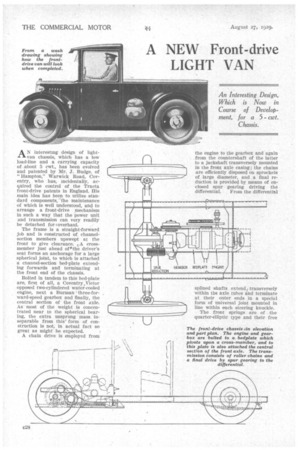ANEW Front-drive LIGHT VAN
Page 50

Page 51

If you've noticed an error in this article please click here to report it so we can fix it.
A N interesting design of light1-van chassis, which has a low load-line and a carrying capacity
of about 5 cwt., has been evolved
and patented by Mr. J. Budge, of "Hampton," Warwick Road, Cov
entry, who has, incidentally, ac quired the control of the Tracta front-drive patents in England. His main idea, has been to utilize stan
dard components, -the maintenance of which is well understood, and to
arrange a front-drive mechanism in such a way that the power unit and transmission can very readily be detached for I:overhaul.
The frame is a straight-forward job and is constructed of channelsection members upswept at the front to give clearance. t A cross
member just ahead of:the driver's seat forms an anchorage for a large spherical joint, to which is attached a channel-section bed-plate extending forwards and terminating at the front end of the chassis.
Bolted in tandem to this bed-plate are, first of all, a Coventry,Victor opposed two-cylindered water-cooled engine, next a Burman'three-forward-speed gearbox and finally, the central section of the front axle. As most of the weight is concen trated near to the spherical bearing, the extra unsprung mass in separable from this' form of construction is not; in actual fact so great as might be expected.
A chain drive is employed from the engine to the gearbox and again from the countershaft of the latter to a jackshaft transversely mounted in the front axle casing; the chains are efficiently disposed on sprockets of large diameter, and a final reduction is provided by means of enclosed spur gearing driving the differential. From the differential
splined 'shafts extend, transversely within the axle tubes and terminate at their outer ends in a special form of universal joint mounted in line within each steering knuckle.
The front springs are of the quarter-elliptic type and their free ends simply pass through stirrups secured to the front-axle tubes, as they only provide for transverse stability and load-carrying, the tractive effort being conveyed through the spherical joint" direct to the cross-member of the frame. The rear Springs are semi-elliptics, underslung and secured to a cranked rear axle. The rear-wheel brakes are coupled to the pedal and the hand lever operates a transmission brake placed cin the jackshaft of the final drive.
The patented Tracta joint is an ingenious piece of mechanism, whicktis designed to convey motion without any fluctuations of angular velocity, and it should, we Think, find uses apart from the
chassis such as we have described. As will be seen in one of the accompanying drawings, forks on each of the two shafts are coupled together by two interconnected ball members with sliding surfaces having a certain degree of freedom.
The mechanism, therefore, amounts in practice to two joints in one, the alteration in angular velocity which occurs in the first part being corrected by the move ment of the second part. This• is, of course, a very important feature, as an ordinary universal joint 'sets up quite considerable fluctuations he speed when the shafts which it connects are working at anything more than a slight angle.
Mr. Budge has nearly completed the building of his first chassis, which will shortly be ready for having a body mounted upon it; following this it will be given a prolonged road test. It is estimated that such a van could readily be produced to sell complete at about £150 and the inventor would be glad to get into touch with manufacturers regarding its further developmen t.












































































































